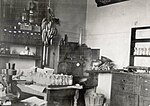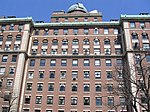Columbia Water Center
The Columbia Water Center (CWC) was established in January 2008 as Columbia University branch Earth institute on researching and addressing global water-related challenges, including water scarcity, access and quality, alongside Climate risks and changes.Its stated mission is to "creatively tackle water challenges of a rapidly changing environment and Earth’s biodiversity contribution of humanity’s carbon footprint affecting the water including climate change affecting food, energy, ecosystems and urbanization," by combining "the rigor of scientific research with the impact of effective policy."The Center takes a multidisciplinary approach to their mission, employing hydrologists, climatologists, environmental engineers, and water policy analysts. Its directors are Upmanu Lall and Carol Silberstein, Professor of Earth, Environmental Engineering, Civil Engineering and Engineering Mechanics at Columbia University.Pierre Gentine, assistant professor in the Department of Earth and Environmental Engineering, also takes a leading role in the Center, with his own PhD and Post-doctoral team focusing on the interactions between soil and atmospheric moisture.The Center currently divides its projects into five themes: America's Water, The Global Floods Initiative, Data Analytics and Multi-Scale Predictions, Risk and Financial Instruments and the Water, Food, Energy Nexus.
Excerpt from the Wikipedia article Columbia Water Center (License: CC BY-SA 3.0, Authors).Columbia Water Center
West 120th Street, New York Manhattan
Geographical coordinates (GPS) Address Nearby Places Show on map
Geographical coordinates (GPS)
| Latitude | Longitude |
|---|---|
| N 40.80945 ° | E -73.95999 ° |
Address
Mudd Hall (Seeley Wintersmith Mudd Hall)
West 120th Street 500
10027 New York, Manhattan
New York, United States
Open on Google Maps







